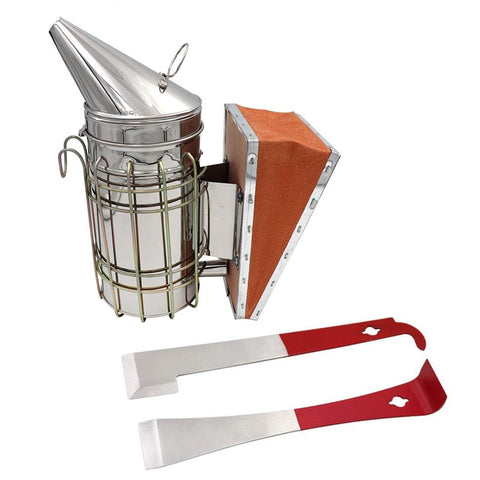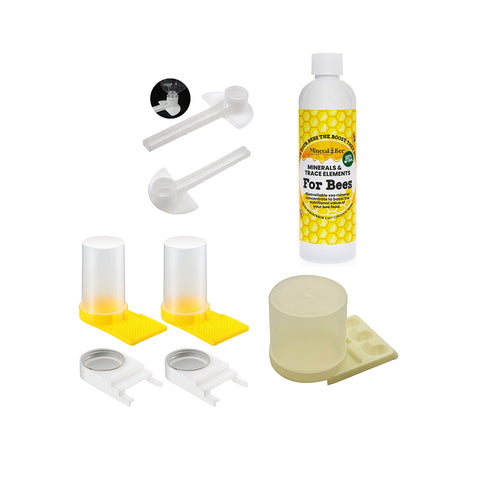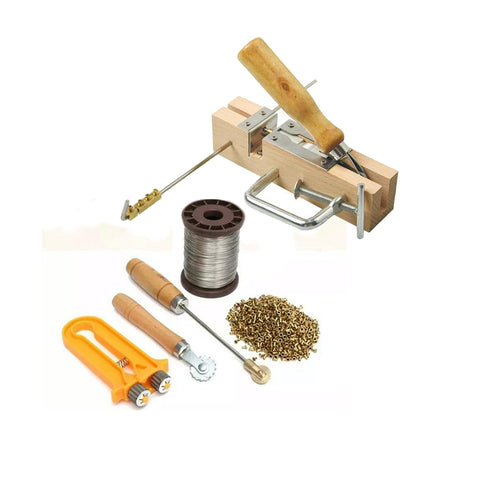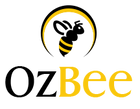Tools for maintaining hives are crucial for any beekeeper. They are employed to divide hive parts and make the beehive easier to check. The hive tool's straightforward construction comprises a hook and a short, blunt blade made of hardened steel on opposite ends. These devices can be used for several tasks, such as pulling the beehive lid off, removing the bur comb, separating supers or boxes, feeding bees with Bee Hive feeders, clearing dirt from the floorboard, releasing some hive components, like frames, and scraping stings.
When inspecting several hives, in particular, the hive tool should always be maintained clean and clear of honey. This will assist in reducing the spread of prevalent bee illnesses as American and European foulbrood.

Additionally, choose a hive tool that is easy for you to grasp and is brightly colored so that you can easily identify it if it falls to the ground. This is a crucial tool for beekeepers and has numerous uses in addition to those listed above.
The most effective tools for Bee Hive:
Today, there are numerous hive tools available, produced by numerous brands. For individuals without the advantage of hindsight, choosing the best option among them might be challenging. That is the reason we have chosen to give you our list of the top hive tools that are now on the market. Let's investigate them.
- Smokers and several hand instruments are mostly used to inspect hives, while foundation and frame support equipment keeps them stable.
- Queen-rearing and swarm-capture instruments are easily available to order at OzBee if you wish to get further involved in beekeeping operations.
- To make transferring hives, nucs, and package bees simpler, our beekeeping store also provides specialized hive and honey transportation tools.
Bee Hive Equipment & Smokers
A range of hand tools and smokers are available from OzBee.
Hive Tools
We provide a range of hand instruments for honey harvesting and hive inspection duties at our store.
One of the most crucial items for a hive check is the hive tool. This is used by beekeepers to separate propolis-glued brood boxes, supers, and frames.
Both traditional and Italian hive tools are available from us.
Tools for uncapping: These are only needed to collect honey. These instruments come in many different forms from uncapping forks to uncapping scratchers to uncapping rollers to electric uncapping knives, among others.
Smokers:
Beekeepers that utilize smokers do so to divert honey bees from inspecting the hive. Smokers all do the same thing. Personal preference ultimately determines which smoker to choose.
Smoker fuel should be added and lit before using a smoker. Various materials, such as cotton, burlap, and wood pellets, are used as smoker fuel. Here, cotton fuel is advised because it is the simplest to light and creates cool, non-toxic smoke for bees. To control your honey bees, you must have a reliable beekeeper smoker.

By inhaling cool smoke at the beehive's entrance and the top of the frames, beekeepers employ smokers to soothe honey bees. The beekeeper checks the frames for honey, pollen, and an egg-laying pattern as the honey bees are distracted by the cool smoke.
The beekeeper can determine the health of the honey bee colony by looking at how much pollen and honey has been stored thanks to this crucial checkup procedure. The number of eggs laid by the queen bee and if honey bees have drawn out replacement queen bee cells is indicators of the strength of the bee queen.
Bee Brush:
The beekeeper uses a bee brush with long, soft bristles to gently sweep bees out of the frames while extracting honey. Beekeepers take great caution when removing bees to avoid harming them.
One of the best beekeeping tools is the bee brush. With the brush, you may remove the bees from the hive frame and yourself. There are numerous additional beekeeping procedures you may utilize these other from these two.
With the extra benefit of the bees' safety, it is a practical addition to your beekeeping toolset. The bees may be lightly brushed off without suffering even the slightest harm. The last thing you would want to do is harm your bees. It makes sense to include one of them in your beekeeping supplies.
Bee Hive Feeders:
However, there are some circumstances in which our bees may use some assistance. These circumstances are generally brief, and precise, and may call for the employment of a feeder. This is a piece of gear that beekeepers can use to provide their bees with more resources. The feeder is a preferred alternative among all the beehive parts or accessories.

Bee Hive Straps:
If you've ever struggled to separate propolis-glued bee boxes, it could appear that a beehive doesn't require any additional maintenance. However, a lot of beekeepers include hive straps, especially before winter when a broken-open hive could have disastrous results.
There are two types of hive straps: those with mechanically assisted ratchet mechanisms and those with cam buckle closures.
Hive Frame Wiring tools:
When utilizing wax foundation in your hive, you must prepare your frame by wiring it after frame assembly but before installing the foundation. The drawn comb is kept from sagging in the frame by the wire, which also serves to strengthen the comb against breakage during honey extraction.

Getting A Frame Wired
An assembled frame, frame wire, eyelets, an eyelet punch, a hammer, needle nose or lineman's pliers, and 5/8′′ frame nails are required before you start.
Honey Harvesting Tools:
Using our honey harvesting tools, you may quickly and effectively remove the bees from your honey supers. A bee brush, an escape board, or a fume board are the three primary pieces of equipment for honey collecting.
When collecting honey, use a bee brush to simply brush the bees out of the way.
You install an escape board on the hive between the supers and the brood chamber as a "door." Bees can leave the super, but they cannot come back because of the way it is built. This takes around 24 hours to get every bee out of the hive.
After you've sprayed a bee repellent on the fabric insert of the fume board, position it above the honey supers.
Beekeepers can assess the condition of their hive at any time by doing hive inspections. Find out here the best tools and instruments for a hive inspection.

